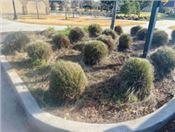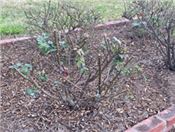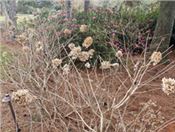It’s Time For Spring Cleanup In The Landscape Heather Kirk-Ballard
BATON ROUGE, LOUISIANA
As winter draws to a close and we eagerly anticipate warmer weather and the longer days of spring, it’s time to get to work in our lawns and gardens. Cleanup in the landscape should include the removal of weeds, trimming limbs and mulching. This also is a great time to fertilize blooming plants, fruit trees and shrubs.
If you haven’t already, cut back your ornamental grasses to encourage new growth in the spring. Use pruning shears for small-bladed grasses and trim two-thirds of the plant, stopping at about 6 inches above the ground. If the grass blades are long enough, you can bundle them into a “ponytail” and cut straight across. The result is a landscape of little round balls.
If you have large, established clumps of grasses such as giant canes (Arundo donax), pampas grass (Cortaderia selloana), Chinese silver grass (Miscanthus sinensis), purple fountain grass (Pennisetum purpureum) and zebra grass (Miscanthus sinensis), you may need to use a bladed weed trimmer or electric or gas-powered hedge trimmers. If possible, tie the tops together to help with the cleanup process. You can throw the grass bundles away in the trash pile – or better yet, compost them!
Early spring is a good time to plant new ornamental grasses in your landscape. (If you miss your opportunity this spring, you can try again in early fall.) Plant before the summer heats up, allowing the plants time to establish a good root system before higher temperatures set in. It also is a good time to plant just about anything in the garden. Avoid cool-season bedding plants and vegetables that cannot tolerate summer heat.
Summer-blooming shrubs and those that bloom on new wood growth also can be cut back this time of year to tidy up the lawn before these plants put on new growth. Some examples of plants that flower on new wood include butterfly bush, panicle hydrangeas, roses and rose of Sharon. Flowering on old wood means that the plant already formed new buds during the late summer or fall months.
If you haven’t trimmed your roses by now, get to it quickly. You want to trim back dead canes and gangly limbs before they begin flushing out new leaves and growing new buds. We typically recommend pruning roses by Valentine’s Day, but we still have a few more weeks before plants really flush out new growth and flowers.
Wait to trim spring-blooming shrubs until after they have completed their blooms. These include azaleas, bridal wreath (spirea), forsythia, viburnum and wigelia. Clean flower beds by removing weeds, and add amendments such as compost to bring up nutrient levels for spring and summer bedding plants.
Now it’s time to make new plant selections for your beds! Many independent retail garden centers are loading up on color right now for spring.
In addition, the LSU AgCenter will be hosting its annual Spring Garden Show at Parker Coliseum on Saturday, March 12, and Sunday, March 13, from 9 a.m. to 4 p.m. both days. We are very excited to be able to host this event again after two years off. This is an excellent opportunity for gardeners to pick up plant materials just in time for spring gardening.
There will be several vendors with a wide selection of plant materials from annual bedding plants, perennials, flowering and evergreen shrubs, fruit plants, vegetables, trees and houseplants in addition to many other gardening items. There will be an Ask the Expert booth where extension specialists will be available to answer gardening questions from insects and disease to proper gardening techniques. ∆
HEATHER KIRK-BALLARD: LSU AgCenter

Ornamental grasses are trimmed back in late winter to promote a new flush of growth in early spring.
Photos by Heather Kirk-Ballard/LSU AgCenter

Roses should be trimmed back mid-February to early March before new spring growthSummer-blooming shrubs such as panicle
hydrangeas and those that bloom on new wood growth can be cut back this time of year to tidy up the lawn before they put on new growth.
